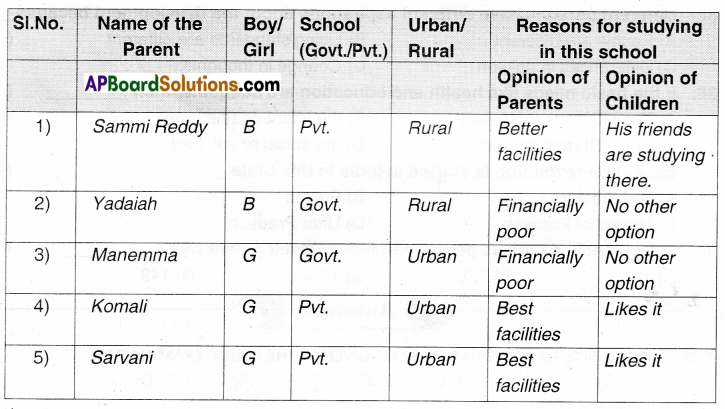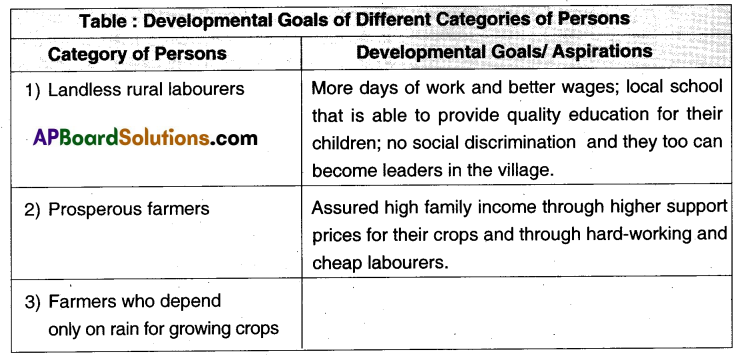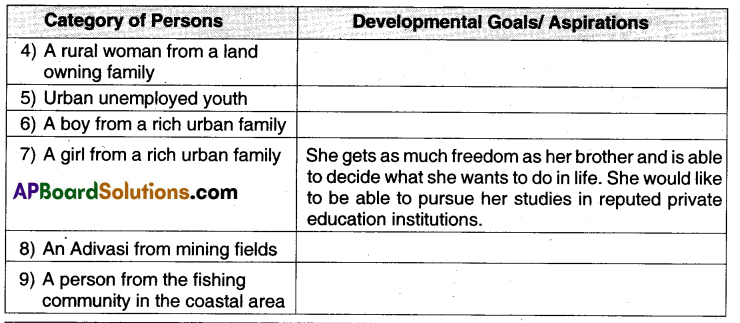Telangana SCERT 10th Class Social Study Material Pdf Telangana 2nd Lesson Ideas of Development Textbook Questions and Answers.
TS 10th Class Social 2nd Lesson Questions and Answers – Ideas of Development
Question 1.
What is the main criterion used by the World Bank In classifying different countries? What are the limitations of the above criterion, if any?
Answer:
The main criterion used by the World Bank in classifying different countries is the per capita income or average income of a person in a country.
Limitations of this criterion:
- It does not tell us about how this average income is distributed among the people in the individual countries.
- Two countries with the same per capita income might be very different with regard to income distribution. One might have equitable distribution of income while the other might have great disparities between the rich and the poor.
Question 2.
Usually, behind each social phenomenon, there would be several contributing factors, and not one. What factors that came together for the development of schooling In Himachal Pradesh?
Answer:
Factors for the development of schooling in Himachal Pradesh (In my opinion) are:
- Free and compulsory education.
- Parental care.
- Mid-day meals scheme.
- Free supply of textbooks and notebooks.
- Encouragement like scholarships, etc.
- Attendance rate.
Question 3.
In what respect is the criterion used by the UNDP for measuring development different from the one used by the World Bank?
Answer:
1. UNDP uses the criteria of Human Development Index.
2. It gives us a transparent and dear-cut Information about the development of the population in that particular area.
3. It measures the development of the people on the following basis:
- Life expectancy.
- Literacy Rate.
- Per capita income
4. But the World Bank uses only per capita income to measure the development of the particular area.
![]()
Question 4.
Do you think there are certain other aspects, other than those discussed in the chapter that should be considered in measuring human development?
Answer:
- The aspects that are considered in measuring human development are per capita income by World Bank.
- Along with per capita income. the education levels of people and health status are considered by the UNDP.
- There are other aspects to be considered.
- Standard of life is one aspect to be considered.
- Another aspect to be considered is availability of electricity.
- Transportation is also one among them.
- Sanitation facilities is one such aspect.
- Availability of irrigation facilities and housing, etc. are few other aspects to be considered in measuring human development.
Question 5.
Why do we use averages? Are there any limitations to their use? Illustrate with your own examples related to development.
Answer:
We use averages because they are useful 1er comparing different quantities of the same category.
e.g.: To compute the per capita income of a country, averages have to be used because there are differences in the incomes of diverse people.
Limitation: Even though they are useful for comparison, they may also hide disparities. e.g.: The infant mortality rate of a country does not differentiate between the male and female infants born in the country. Such an average tells us nothing about whether the hunter of children dying before the age of one are mostly boys or girls.
Question 6.
What lessons can you draw about the Importance of income that Himachal Pradesh with lower per capita income has a better human development ranking than Haryana?
Answer:
It reveals that per capita income does not show better human development. For example, our money cannot give us all our necessities to live well. Therefore, in spite of low per capita income Himactial Pradesti has better human development because Himachal Pradesh has other facilities than Haryana like health and education facilities.
Question 7.
Based on the figures in the Table (6) given below, till the following:

Out of every 1oo female above 6 years of age, …………………. females had studied beyond the primary level in Himachal Pradesh in the year 2001. By the year 2011. This proportion reached …………………. out of 100. For India as a whole, the proportion of male who had studied beyond primary level was only …………………. out of 100 in the year 2011.
Answer:
Out of every 100 females above 6 years of age. 67 females had studied beyond the primary level in Himachal Pradesh in the year 2001. By the year 2011. this population reached 76 out of 100. For India as a whole, the proportion of males who had studied beyond primary level was only 82 out of 1oo in the year 2011.
Question 8.
What Is the per capita income of Himachal Pradesh? Do you think higher incomes can make it easier for parents to send children to school? Discuss. Why was It necessary for the government to run schools in Himachal Pradesh?
Answer:
- The per capita income of Himachal Pradesh in 2017-18 is Rs. 1.86 lakhs.
- Higher-income can make it easier for parents to send their children to school.
- 11 the incomes are meager, then parents cannot spend money on education of their children.
- Then children ought to supplement with their labour to run the family.
- It higher incomes are there for family, these can be avoided.
- Himachal Pradesh had very low levels of education at the time of Independence.
- Being a hilly region, with low density of population ¡ri many villages, spread of schools is a big challenge.
- So, it was necessary for the government to run schools In Himachal Pradesh.
Question 9.
Why do you think do parents accord less priority to girls education es co,npa red to boys? Discuss In the class.
Answer:
- Parents give less priority to girls education compared to boys.
- The main reason behind this Is gender bias.
- Parents believe that boy is their heir and spreads their clan.
- This very notion Imbibes into children as father Is the decision-maker in the family.
- As marriage institution provides for the girl to live with husband’s family, her parents take less care about her education.
- Well-educated girls needed to be married off to stI better-educated suitor, an expensive affair.
- Girls are engaged in taking care of their smaller siblings, which obstructs their educational chances.
- in rural areas girls are married off at early ages, which prevents their education.
Question 10.
How does the gender bias affect when the women work outside of the home?
Answer:
Before the rise of large-scale industrialization, home, and workplace were one and the same. But now the disparity between men and women in the workplace is a common issue. Workers acknowledge gender discrimination is possible in modern organizations, but at the same time maintain their workplaces to be gender neutral.
Women are facing a high degree of gender bias when It comes to their careers. There is a general perception that women are less capable than men in matters of business and decision-making.
![]()
It is often a strenuous struggle for a woman not just to her motile but also to make a deserving way to the top. Career goals of women are considered less important compared to male counterparts. The disparity is also seen in the wages and salaries also. Thus the relationship is negative.
Question 11.
In the class 8th you read about the Right to Education Act. In the light of what you have read In this chapter end already know, discuss the importance et this Act for (i) children and (ii) human development.
Answer:
i) The Importance of the RTE for children:
- The act makes education a fundamental right of every child between the ages of 6 and 14.
- It mandates all private schools to reserve 25% of seats for children.
- It also prohibits all recognized schools from practicing and makes provisions for no donation or capitation fees and no interview of the child or parent for admission, etc.
- The act is the first legislation in the world that puts the responsibility of ensuring enrollment, attendance, and completion on the government.
ii) For Human Development:
Education is the key component of human development, ills also a great liberating force. So the act serves as a building block to ensure that every child has his or her right to get a quality elementary education and that the state, with help of families and communities, fulfills this obligation.
Project
Question 1.
Here Is an illustration showing different sources of livelihood. Create a similar Illustration and write a caption that would describe their notion of development.

Answer:
Student Activity.
Question 2.
Collect information from the parents, in which schools their children are studying and analyse on It In the classroom.

Answer:

Analyzation:
The urban and rural rich are opting private schools while the urban and rural poor are opting government schools.
TS 10th Class Social 2nd Lesson Ideas of Development Intext Questions
Page No. 15
Question 1.
Let us try to Imagine what development or progress is likely to mean to different persons listed in the given table. What are their aspirations? You will find that some columns are partially filled. Try to complete the Table. You can also add any other category of persons.


Answer:

Development promises a real growth through changes and in light of these changes, it is worth examining the implications of a broad move to sustainability. An economy built on the values of sustainable development will anticipate a new respect and economic role for labour.
Page No. 17
Question 2.
What can be some of the developmental goals for your village or town or locality?
Answer:
Some of the developmental goals for our village are
- to be provided with safe drinking water and sanitation facilities.
- to start a primary health center with minimum facilities.
- to recruit Suffident teachers and provide other facilities to schools.
- to provide employment to eligible youth.
Question 3.
What are the issues of conflict between government and the people living in regions of nuclear power plants?
Answer:
- The issues of conflict between the government and the people living in the regions of Nuclear Power plants are (a) Safety. (b) Security and (C) Livelihood.
- People also suggested the government to look to renewable energy as an alternative.
Question 4.
Do you know of any such controversy around development projects/policies? Find out the debates on either side. How do we find solutions that are fair.
Answer:
- One such controversy around development project is Narmada River Protect n Gujarat.
- Government aimed at large electricity to be produced with this project would serve the power needs of the state.
- It also provides many small dams for irrigation water.
- On the other hand, people under the leadership of Modha Patkar set up Narmada Bachao Andolan and fought with the government
- They are fighting for the people displaced. their lands evacuated and villages that are going to be submerged.
- They have also concerns over ecological in Imbalances and loss of the tribal culture.
Page No. 18
Question 5.
Read this newspaper report ……………..
“A vessel dumped 500 tonnes of liquid toxic wastes into open-air camps in a city and. In the surrounding see. This happened in a city Abkan in Ivory Coast. a country in Africa. The fumes from the highly toxic waste caused nausea, skin rashes, fainting, diarrhea, etc.
After a month seven persons were dead, twenty in hospital, and twenty-six thousand treated for symptoms of poisoning. A multinational company dealing in petroleum and metals contracted a local company of the Ivory Coast to dispose the toxic waste from Its SLP.”(Accepted from article by Vaýu Nasravane 16 September 2006, The Hindu).
Now answer the following questions:
a) Who are the people who benefited and who dId not?
b) What should be the developmental goal for this country?
Answer:
a) The local company owner and the multinational company benefited, while a large number of Innocent local people of Abidjan in Ivory Coast suffered from this act.
b) The developmental goals for this country should be to framed and have proper, strict rules and laws regarding the pollution and safer environment, etc. People or any organization violating these Laws. causing environmental hazards should be punished by the government according to these laws. Also, the country should create arrangements for proper disposal of Industrial wastes or better health care for the people.
![]()
Question 12.
Suppose the records show that the average Income in a country has been increasing over a period. From this can we conclude that all sections of the economy have become better? Illustrate your answer with an example.
Answer:
It does not show how the income is distributed among people. So we cannot conclude that all sections of the economy have become better.
e.g.: Two countries named X & Y. Each has 3 families, The incomes 01 3 families in ‘Y’ country are Rs. 10,00W-. Rs. 50,000/- and Rs. 1,50.000/- p.a. respectively. The incomes of 3 families in ‘X’ country are Rs. 60,000/-. Rs, 70000’- and Rs. 800001- p.a.respectively. The per capita income of both countries is Rs. 70,000/-. In this example even though the average Income same, there is more disparity of income of ‘Y’ country.
Question 13.
From the text, find out the per capita income level of middle-income countries as per World Development Report, 2017.
Answer:
The per capita income level of middle-income countries as per World Development Report. 2017 is above US $ 995 per annum and below US $ 12,055 per annum.
Question 14.
Write a paragraph on your notion of what India should do or achieve to become a
developed country.
Answer:
To become a developed country, India should accelerate its GDP growth. Special emphasis should be given on agriculture or small-scale industries. More than 60% India’s labour force is engaged in agriculture sector which contributes only about 27% In GDP.
Moreover, in the globalization process, this sector has been neglected. As a result, the growth rate of this sector has decreased. There is urgent need to increase its growth rate by providing modem agricultural Inputs, training, credit, marketing facilities, etc. to the farmers.
We need to develop our infrastructure, labour intensÑe techniques, and credit and marketing facilities and must reduce corruption and red-tapism in government offices. Apart from these, there are other areas where India requires to pay more attention are such as health and sanitation, vocational training, employment generation, etc.
Page No. 23
Question 15.
Look at the data in Tables 3 and 4 (given on Page No. 21 and 22 In Textbook). Is Karyana as ahead of Biher In literacy rate, etc. as It is in terms of per capita income?
Answer:
- Haryana is ahead of Bihar in terms of per capita Income.
- It is Rs. 180174 for Haryana, whereas it is Rs. 34409 only for Bihar.
- Haryana is ahead of Bihar in both Literacy rate and Net Attendance Ratio for secondary states.
- They are for Haryana 77 and 61 respectively, whereas for Bihar are 64 and 43 only.
- Bihar is ahead of Haryana in Infant Mortality Rate.
- Haryana has less 33 IMR, whereas Bihar has 38 IMR.
Question 16.
Think of other examples where collective provision of goods and services is cheeper than individual provision.
Answer:
- Collective security for the whole locality is cheaper than individual security to each house.
- A pond or playground for all people will be cheaper than individual ones.
Question 17.
Does availability of good health and educational facilities depend only on the amount of money spent by the government on these facilities? What other factors could be relevant?
Answer:
Availability of good health and educational facilities do not depend only on amount of money spent by the government on these facilities but also on the social factors.
For e.g.: Himachal Pradesh is more developed than Punab according to the present categones because its infant mortality rate is lower and the literacy rate is higher. The sex ratio Is also higher in case of Himachal Pradesh and Punjab.
![]()
Question 18.
For family in rural areas in Tamil Nadu and combined Andhra Pradesh In 2009-2010, rice purchased from ration shops account for 53 and 33 percent respectively. The rest they buy from markets. In West Bengal and Assam. only 11 and 6 percent of rice is purchased from ration shops. Where would people be better off and why?
Answer:
The people of West Bengal and Assom would be better off.
Reason: They purchase only 11% and 6% of rice from ration shops When compared to Tamil Nadu and combined Andhra Pradesh their purchase from markets is very high.